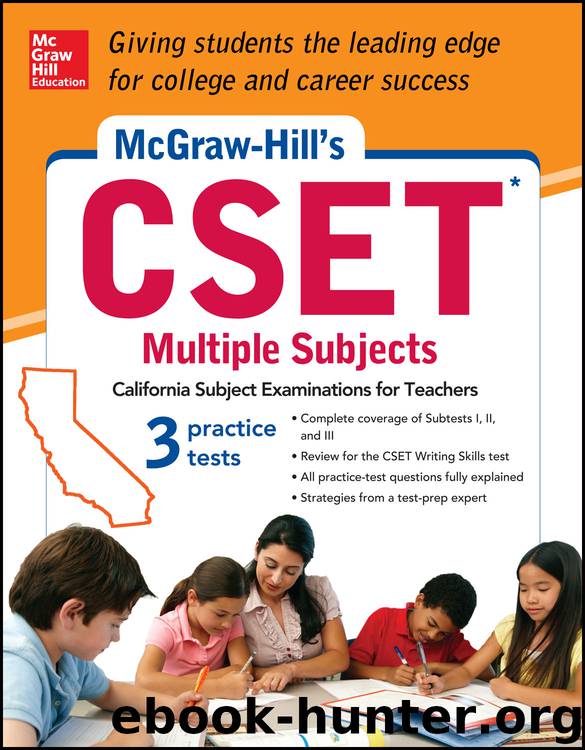McGraw-Hill's CSET by Cynthia Johnson

Author:Cynthia Johnson
Language: eng
Format: epub
Publisher: McGraw-Hill Education
Domain 4: Visual Arts
The questions on the CSET addressing visual arts will relate to a range of artistic forms, including not only paintings and sculptures, but also photos, prints, carvings, and architecture. You will need to understand the visual elements around which visual arts are created and be able to analyze and evaluate representations based on these elements, as well as on the principles of design. The following list identifies some of the concepts and skills you will need to understand in order to do your best on subtest III of the CSET:
Basic fluency with the principles of art
Ability to distinguish between the elements of art and to recognize ways in which these elements are affected by light and shadow
Analysis of the creative process and the impact of artists on thinking and culture
Ability to explain, describe, compare, and contrast styles of visual arts representing various times, places, themes, and cultures
Capability to interpret works of art to derive meaning and make judgments based on the principles of art
Use of design principles to describe art and explain how these affect the quality of a piece
Recognition of the mood of a work of art
Understanding of how to integrate visual art with other art forms and disciplines
Visual Arts Vocabulary
The following list includes terms and concepts related to the four areas of visual arts. It will be important to understand the terms and be able to apply the concepts.
abstract art: composition or piece of art that includes unrecognizable representations of actual objects or thoughts
allegory: symbolic artwork
amphora: a narrow-necked Grecian urn, usually made of clay and having two handles
annealing: the process of heating hardened glass or metal in order to soften it
arabesque: ornate, detailed design that incorporates plant life and geometric patterns
asymmetry: the effect achieved when a piece of work has a sense of balance created by the lightness and color of different parts of the piece
avant-garde: art thought to be innovative, unconventional, or ahead of its time
balance: the sense of visual stability or equilibrium in a piece of art
battens: wooden slats on which plaster or tiles are attached
bevel: a slanted or rounded edge
biscuit: porcelain that has not been glazed
bust: a sculpture that shows only the head and shoulders of the subject
calligraphy: a type of decorative, artistic handwriting
canopy: a covering made of fabric
carvings: designs made by cutting wood or stone
ceramics: objects made from porcelain or hard, fired clay
chalice: ornamental cup used in religious services for Communion or Mass
chancel: area of a church near the altar, which is reserved for the clergy
chroma: the brightness or dullness of a color; also called saturation or intensity
collage: type of art that is created by pasting various types of media, including paper, fabric, wood, photographs, paintings, or drawings, onto a surface
color: the visible light that is reflected off of objects
contrast: the artistic representation of two opposites, used to represent dramatic differences in a composition
course: one layer of stones or bricks that make up a wall
cuneiform: belonging to an ancient writing system that involved making wedge-shaped impressions in soft clay
decoupage: cut-out designs
Download
This site does not store any files on its server. We only index and link to content provided by other sites. Please contact the content providers to delete copyright contents if any and email us, we'll remove relevant links or contents immediately.
1,001 ASVAB Practice Questions For Dummies by Powers Rod(4471)
ASVAB For Dummies by Powers Rod(2805)
Churchill by Paul Johnson(2544)
Police Exams Prep 2018-2019 by Kaplan Test Prep(2516)
Wonder by R J Palacio(2182)
Wiley CPA Examination Review Focus Notes by Kevin Stevens(1936)
1936941139 (N) by Bob Rosenthal(1867)
First Aid Handbook--Crucial Survival Skills, Emergency Procedures & Lifesaving Medical Information by Department of the Army(1810)
ASVAB AFQT For Dummies by Rod Powers(1646)
A Very Stable Genius by Philip Rucker & Carol Leonnig(1646)
Future Design by Unknown(1532)
1,001 ASVAB AFQT Practice Questions For Dummies by Angie Papple Johnston(1477)
U.S. Army Combat Pistol Training Handbook by Army(1471)
CISSP For Dummies by Miller Gregory Peter(1460)
Tests and Proofs by Unknown(1451)
The GED Crash Course by Alpha(1421)
Master the Civil Service Exams by Peterson's(1395)
McGraw-Hill Education 2,000 Review Questions for the CPA Exam by Denise M. Stefano(1366)
Court Officer Exam by Learning Express LLC(1362)
